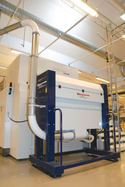ASK THE EXPERTS: How to increase productivity and save money
21 January 2010Kongskilde has developed a number of cutting and conveying systems which can be installed in a modular fashion, according to changing, needs to remove plastics and paper edge trim, off-cuts and die-cut waste from processing equipment directly to storage areas and finally to disposal or recycling. James Panton, northern area sales manager, spoke to Converting Today
Kongskilde UK is a subsidiary of the Danish-based Kongskilde Group. The company has three major divisions, one of which is industry and involves designing and manufacturing process waste handling systems for the plastics, packaging and printing industries. James Panton is the northern area sales manager in the UK. Converting Today spoke to him recently about the company’s waste handling systems.
What are the main considerations when a company has a waste problem? According to Mr Panton, in many cases companies invest a great deal in state-of-the-art processing equipment but often neglect the need to handle the process waste generated by their expensive equipment in an efficient manner. “We are often called in by companies where the process waste is affecting their production speeds,” said Mr Panton. “Our aim then is to design a system to remove the process waste as efficiently as possible to allow the customers’ equipment to operate to its full potential. These systems can also reduce the labour of maintaining a clean factory environment, which is also an important safety issue. The paper industry in particular generates a large amount of dust with each process. Using a vacuum conveying system alleviates the problem by carrying away the dust with the paper edge trim.”
Kongsklide’s systems are able to handle a variety of waste including paper, cartonboard, film and foil offcuts and trim from the print and packaging sectors. Mr Panton explained what a typical waste handling system consisted of, using the example of installations carried out at PSG Group, a polyester converter based in London. “As a solution to PSG’s waste handling problems we initially supplied a single trim system for a cleanroom slitter with a design of two heavy gauge edge trims up to a maximum of 40mm, 250 micron thick at a rate of 500m/min. This pneumatic system needed to convey the polyester trim some 30m to an outside collection area. We achieved this using an in-line Multicutter, Venturi (allows speeds of up to 1,000m/min) and a high pressure acoustically enclosed Multiair fan.”
The Multicutter unit was particularly important to the customer as it was able to dramatically reduce the volume of the conveyed trim material, removing the need for a compactor or baler. Lawrence Gardezi, MD of PSG, commented: “We have made a huge saving since installing the system. We have reduced waste costs, increased productivity, reduced workforce (we used to employ a full-time cleaner to clean around the machines), and ensured health and safety compliance.”
The concept of the Multicutter has now been expanded with a new unit called the MultiDicer, which was introduced in November 2008 (showcased at drupa 2008). James Panton explained that the MultiDicer had been in development for a couple of years in conjunction with a packaging company in Europe and so far seven units have been installed. “The MultiDicer was developed for die cutters: it downsizes the cartonboard skeleton waste released from a die cutter, which would normally be difficult to handle in a conveying system, to a manageable size. This minimises the size of the conveying pipes, which reduces the demands on space for the installation.”
The main benefits for the customer are that the power consumption is minimised by optimising the conveying pipes so smaller blowers, separators and filter systems can be used, which are less expensive. Also, there is a minimum amount of conditioned air removed from the production area. With this system the operator can focus on running the die cutter efficiently and with no need to stop to empty waste containers. The MultiDicer can handle up to 12,000 sheets/hour of cardboard with widths of up to 1,630mm and in gauges from 90g/m² to 1,000g/m².
A major advantage of Kongskilde systems, including those with the MultiDicer, is that they have low maintenance requirements.
The new MultiDicer was introduced to deal with die-cut waste in the packaging industry Kongskilde External weblinksConverting Today is not responsible for the content of external internet sites.Kongskilde


